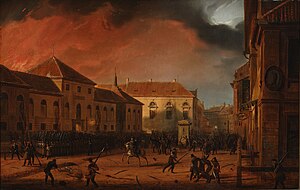
Back انتفاضة نوفمبر Arabic 1831 m. sokėlėms BAT-SMG Паўстанне 1830—1831 гадоў Byelorussian Паўстаньне 1830—1831 гадоў BE-X-OLD Полско въстание (1830 – 1831) Bulgarian Revolta polonesa del 1830 Catalan Listopadové povstání Czech Novemberopstanden Danish Novemberaufstand German Novembra ribelo Esperanto
| November Uprising | |||||||
|---|---|---|---|---|---|---|---|
| Part of the Revolutions of 1830 and Russo-Polish Wars | |||||||
 Taking of the Warsaw Arsenal. Painting by Marcin Zaleski. | |||||||
| |||||||
| Belligerents | |||||||
| |||||||
| Commanders and leaders | |||||||
| Strength | |||||||
|
150,000 |
180,000–200,000 | ||||||
| Casualties and losses | |||||||
| Polish claim: 40,000 killed and wounded[1] |
Polish claim: about 22,000–23,000 killed and wounded[2] | ||||||
The November Uprising (1830–31), also known as the Polish–Russian War 1830–31[3] or the Cadet Revolution,[4] was an armed rebellion in the heartland of partitioned Poland against the Russian Empire. The uprising began on 29 November 1830 in Warsaw when young Polish officers from the military academy of the Army of Congress Poland revolted, led by Lieutenant Piotr Wysocki. Large segments of the peoples of Lithuania, Belarus, and Right-bank Ukraine soon joined the uprising. Although the insurgents achieved local successes, a numerically superior Imperial Russian Army under Ivan Paskevich eventually crushed the uprising.[5][6][7] The Russian Emperor Nicholas I issued the Organic Statute in 1832, according to which, henceforth Russian-occupied Poland would lose its autonomy and become an integral part of the Russian Empire. Warsaw became little more than a military garrison, and its university closed.[8]
- ^ Stefan Kieniewicz, Andrzej Zahorski, Władysław Zajewski, Trzy powstania narodowe, Warsaw 1992, p. 273. (in Polish)
- ^ z dostępnych informacji wynika, że straty pewne to ponad 21 tys. ludzi (suma zabitych podana przy poszczególnych bitwach), jednak nie wszystkie bitwy mają tę statystykę
- ^ Wacław Tokarz, Wojna polsko-rosyjska 1830 i 1831, Warsaw 1993, passim.
- ^
"Parliament Members and Deputies from Cracow and Sandomir Provinces in the Insurrectionary Seym of 1830–1831: The Estimation of Political Attitudes and Views of the Political Elites – an Introduction". Klio: Czasopismo poświęcone dziejom Polski i powszechnym. 12. Toruń: Wydawn. Uniwersytetu Mikołaja Kopernika: 64. 2009. ISSN 1643-8191. Retrieved 28 March 2022.
The article discusses the neglected issue of political activities and attitudes of Parliament Members during the November Uprising (also known as Cadet Revolution).
- ^ The lands of partitioned Poland, 1795–1918, by Piotr Stefan Wandycz. p. 106.
- ^ "Polish Uprising of 1830–31." The Great Soviet Encyclopedia, 3rd ed., (1970–1979). Gale Group, 2010.
- ^ "Polish Revolution of 1830", by Amy Linch. 2009. The International Encyclopedia of Revolution and Protest ISBN 978-1-4051-8464-9.
- ^
Tucker, Spencer C., ed. (2009). A Global Chronology of Conflict: From the Ancient World to the Modern Middle East: From the Ancient World to the Modern Middle East. Vol. 3: 1775–1860. Santa Barbara, California: ABC-CLIO. p. 1157. ISBN 9781851096725.
Czar Nicholas I decrees that henceforth Poland is an integral part of Russia. Poland loses all the special rights that it had supposedly enjoyed; its administration is entrusted entirely to Russian officials. Warsaw becomes little more than a military garrison, its university closed.